Chief Thomas Wetzel of the University Circle (Ohio) Police Department worries police leadership has been asleep at the wheel and hasn’t marketed what officers do for the community.
Finding Grace for the Community
University Circle adds Grace, a community policing dog, to restore trust in the police department.
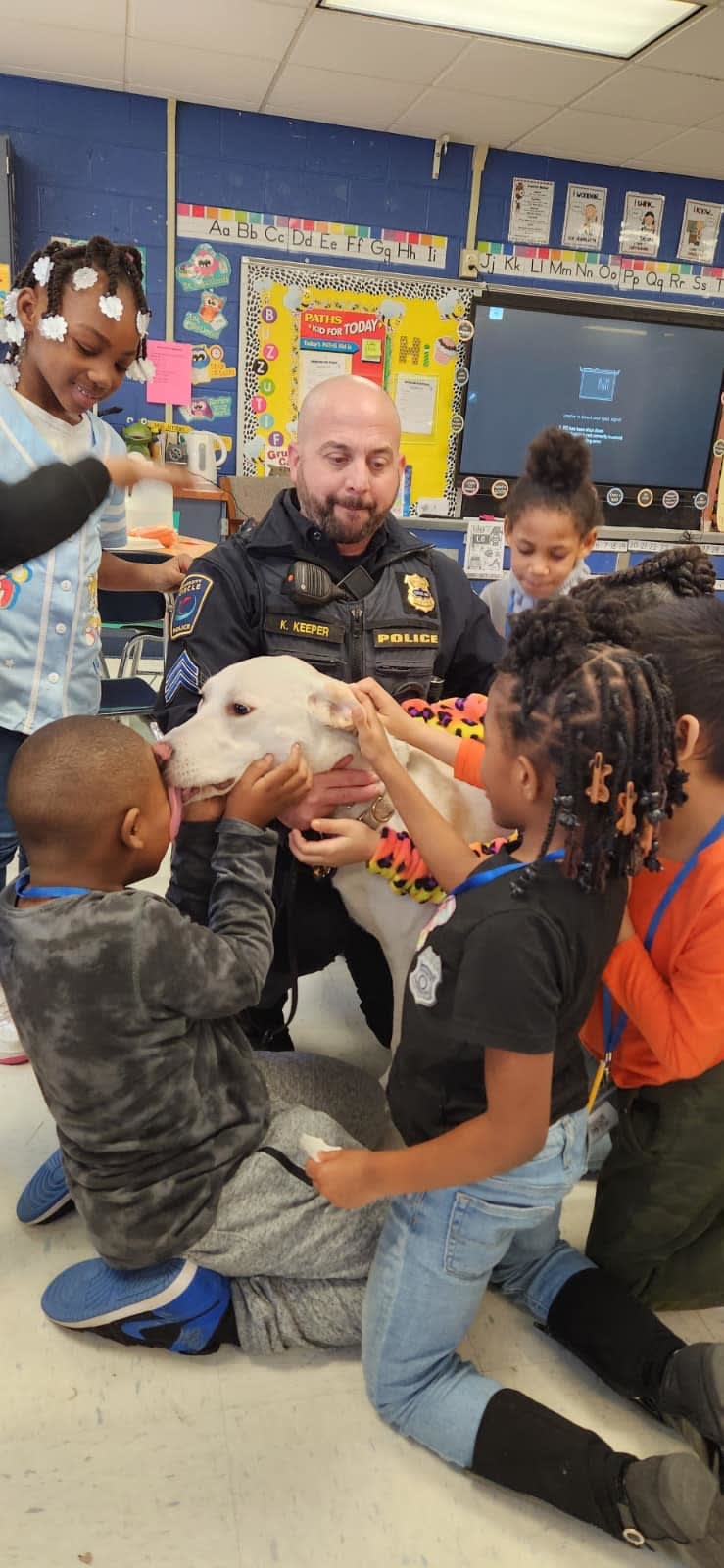
Grace spends a lot of time in the schools, building trust in police everywhere she goes.
IMAGE: University Circle Police Department
“[This complacency] has done a lot of damage to our profession,” he says. “We’re seeing it in low recruitment, community frustration, and in a lack of officer wellness. We need to make efforts to rebuild trust, so people recognize police officers are there for them and are part of the community.”
Wetzel took steps to revive the symbiotic bond between police and the University Circle community about eight months ago, when the department welcomed a new member to its ranks—Grace, a community policing K-9 donated by her trainer, Rick Seyler.
He adds Grace provides handler Sgt. Kurt Keeper, a 16-year veteran of University Circle PD, with a means to engage with the community.
“Kurt could walk around all day and say hello to people. Some might say hello back, but others would just ignore him,” he explains. “But when he’s got the dog, people are curious and want to pet it. Because the dog is with him, it gives him a chance to talk with them.”
Every positive interaction opens a door to restoring trust, he adds.
“I think Grace is going to break a record for how many times she has been petted,” he says. “This dog is petted an insane amount of time, where traditional police dogs are not. Some are not even approachable.”
According to Wetzel, Grace is a natural continuation of the department's current community policing initiatives, such as the Scouts/Police Explorers program and philanthropic endeavors, all aimed at fostering community trust.
Grace for the Community

Graces goes everywhere with handler Sgt. Kurt Keeper.
IMAGE: University Circle Police Department
Grace, a one-year-old yellow lab, stands out from traditional police dogs. In her role as a community policing dog, Grace does not pursue suspects or detect drugs, bombs, or individuals using her sense of smell.
There’s a lot of negativity with police dogs, Wetzel explains, noting Grace turns that tide by only being used for community policing, emotional support and officer well-being.
“We hope to eventually train her to track a missing person, someone who has autism or someone who has walked away from a nursing home,” he says. “But her primary role right now is to connect with the community. We want Grace to be the community’s police dog.”
Despite being one of the few police dogs trained for this purpose, Grace is not Wetzel's first encounter with a community policing dog. As police chief for the Richmond Heights (Ohio) Police Department, Wetzel helped bring in Angel, a white German Shepard, as a K-9 community policing officer.
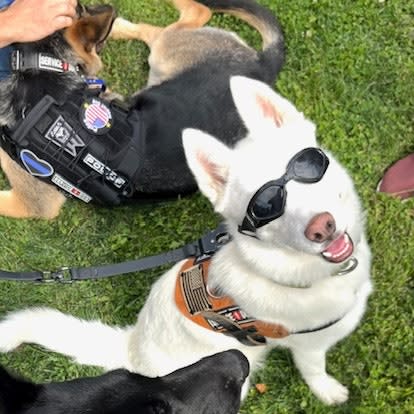
Angel, the country's first community policing dog, served the Richmond Heights, Ohio, community for many years.
IMAGE: Silver Bullet K9 Service Ministry
The department relied on Angel to provide solace to crime victims and support fellow officers. Handler Lt. Denise DeBiase used Angel to interact with schoolchildren and older adults, serve as a mascot for public relations, and help find missing persons.
“I believe Angel was the first dog in the country with that title,” Wetzel says. “We had tremendous success with the dog. Angel yielded a million dollar return.”
Training a Community Policing Dog
As the proprietor of Silver Bullet K9 Service Ministry, Seyler is an animal behaviorist who has dedicated 30 years to training dogs as service animals for armed service veterans dealing with posttraumatic stress disorder (PTSD).
Seyler helps trains service dogs for those in need and offers boarding services when their owners must be away. He even provides refresher training for dogs he has trained when they need to brush up on their skills.
Seyler trained Wetzel’s first community policing dog. After the successful Richmond Heights partnership, Wetzel approached Seyler to train a community policing dog for University Circle. Seyler agreed, selected a labrador retriever named Grace and trained her for two months over the summer to meet the department's goal of introducing her to the community in 2023.
Wetzel reports Seyler picked a labrador retriever because of its naturally friendly demeanor and comfort with people.
“Labradors are very approachable,” Wetzel says. “If you were to take a German Shephard through a crowd, people get concerned. Though the dog may be incredibly friendly, they have a very intense look to them. Grace has a ‘come and hug me’ look and people gravitate toward that. You could have the friendliest German Shephard around, but if people won’t get near it, it won’t accomplish anything. Grace doesn’t intimate anyone.”
Seyler says he imprints the dog (or introduces) it to the community before donating it. “I teach the dog all it needs to know and socialize it properly, then the handler takes it through obedience training,” he explains. “My role is to get agencies, a well-rounded dog that is socialized and desensitized so that it can go into any environment.”
Grace trained in University Circle, Seyler says. “Every Saturday, I took her there to learn about the community and to meet people,” he says, noting he applies what he learned from military working dogs. “I put that together to make a dog that can go anywhere and do anything in any environment,” he says.
Seyler brings the dogs to different environments, including offices, hospitals, streets, and industrial settings. “My dogs are in chiller rooms, on roofs, steel plants and urban areas,” he says. “That desensitizes them. I also desensitize them to gunfire and take them into schools and around children as puppies.”
He shares that he teaches community policing dogs to heel but does not teach them to lie down. “When a dog is completely comfortable in its environment, it will lie down on its own, whether with 100 people or one,” he says.
He adds, “You don’t want to tell the dog to do these things, you want them to do them out of love.”
Training the dog through imprinting saves time and fosters a willing work attitude, while also allowing the handler to establish a bond with the dog at a young age. With other training methods, a handler might not start working with the dog until it’s at least a year old, Seyler explains.
Grace’s training will be ongoing and will include search dog training once the department joins the Ohio Search and Rescue Association.
“The goal is to train Grace as a search dog for missing persons,” Wetzel says. “Grace is a work in progress. The training never stops. But the initial training by Seyler is what makes it possible.”
“He did all the intensive training, but Kurt is taking it to another level,” he says.
Selecting a Handler
Seyler won’t let just anyone have his dogs and requires departments to sign a contract saying the dog will always remain with its handler. This makes handler selection critically important, Wetzel says.
“If Kurt quits tomorrow, we cannot give Grace to someone else,” Wetzel says. “The dog has to stay with him. Rick is very sensitive to making sure the dog is treated well and with the right people.”
University Circle found its handler by soliciting interest from officers willing to handle a community policing dog. Two officers showed interest, and the agency ultimately chose Keeper for the position.
“Rick took Grace as a puppy to Kurt’s home to make sure it was going to work,” Wetzel says. “Kurt had a dog and two cats at home at the time. If the dogs were snarling at each other or the cats scratched at Grace’s face, it would not have worked.”
A Day in the Life
Grace lives a dog’s dream life. Her job is literally to get petted all day, according to Keeper.
He explains she works day shifts, from 6 a.m. to 6 p.m. “She goes where I go,” he says. “We do foot patrols, and visit institutions, businesses and local schools,” he says. “We also do a lot of events, such as Coffee with a Cop. If victim needs comforting, she is there to comfort.”
Grace's presence on duty creates an opportunity for the department to connect with residents outside of policing, at events like Wade Oval Wednesdays or Hike with a Cop. “Any community policing event includes Grace,” Keeper says. “When we walk into a school now, all the kids know Grace. They are on a first-name basis and that is priceless. They have that connection right away with a police dog.”
Grace also provides emotional support for victims of trauma. Wetzel explains they bring in Grace to provide “calm and peace to someone that’s been traumatized by a crime or a domestic violence incident.”
Grace also visits hospitals and families at the Ronald McDonald House, Cerebral Palsy Center and Magnolia Clubhouse. “When she walks into those places, she has a calming effect on the world,” he says.
Keeper states Grace enjoys being in the schools the most. “When she approaches children or they approach her, her tag wags about a mile a minute. She knows she’s doing to get petted by the kids. These dogs are just designed to spread love.”
The department tracks every visit to gather empirical evidence of Grace’s impact on the community. “People request her for various events and things like that,” he says. “She’s a definite draw.”
Besides community policing, Grace boosts morale for department officers, Wetzel says.
“Grace has an officer wellness application,” he explains. “Our guys see trauma all the time and must deal with some really painful things. When they come back after a call, they see Grace here and it takes their mind off of those things. The presence of a dog has a calming effect on a human being. The officers play with her like she’s their own dog.”
Caring for the Community Policing Dog
The average dog costs its owners about $2,500 annually for food, grooming, veterinary checkups, kenneling and more, reports the American Kennel Club. For a cash-strapped department, these expenses can be tough to swing for a community policing dog.
Wetzel says local vets and pet food stores often make donations to defray these costs—all you have to do is ask. “People love dogs and love being part of something like this,” he says. “In Richmond Heights, we had veterinary services and food donated to us.”
He also adds insurance expenses are far less for community policing dogs than for dogs trained in bite work or drug sniffing. “Insurance companies are not as worried about lawsuits and bites with a dog like this, so the costs are lower,” he says.
Making an Impact
Grace is making a positive impact, Wetzel and Keeper agree. “We are confident that she will continue to make an impact,” Wetzel adds.
But Wetzel also hopes Grace inspires other departments throughout the country to get a similar dog.
“It’s good to have many types of dogs,” he explains. “You can have your tracking dog, your drug dog and your bomb dog. There is value in that. But a community policing dog is the counterweight that handles community outreach and makes connections.’
Community policing dogs send a powerful message to the commitment. “It says, ‘We care about you. We care about this community, and we want to connect with you even more by bringing this dog everywhere and letting you watch it grow up,’ ” he concludes.
More Special Units

2026 Ford Pro™ Police & Special Service Vehicles Guide is Available for Download
Ford Pro™ meets the needs of law-enforcement agencies
Read More →
How One Police Department Cut Crime by 46% with Smarter Patrol Management
Discover how one police department cut crime nearly in half using smarter patrol data. This whitepaper breaks down the real-world strategy behind a 46% drop in vehicle thefts, improved officer safety, and stronger community visibility.
Read More →
Ohio’s Statewide Drone First Responder Program to Take Flight
Over the next two years, the Ohio DFR Pilot Program will equip municipalities with advanced drone systems, deliver comprehensive training for first responders, and enable FAA-approved Beyond Visual Line of Sight operations.
Read More →
Louisiana Motor Sergeant Dies from Injuries Suffered in June “Intentional” Crash
A motor officer, Sgt. Caleb Eisworth was on his way to participate in a funeral escort when he was struck by another vehicle.
Read More →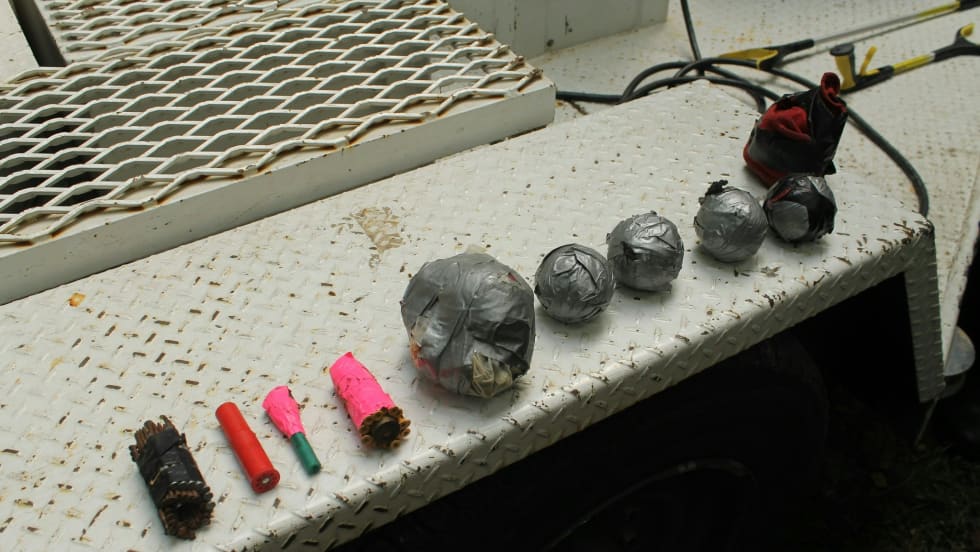
Tennessee Officers Say Man Tried to Detonate IED During Arrest
Inside the bedroom officers found what they believed to be an IED. The officers evacuated the house and called for the Chattanooga Police Bomb Squad and ATF agents.
Read More →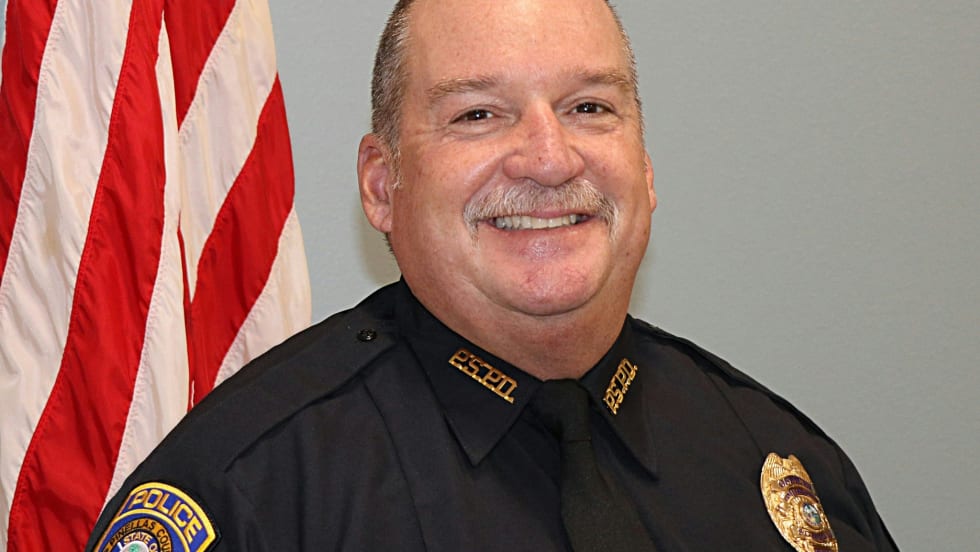
Florida School Officer Dies After On-Duty Medical Emergency
Sergeant Greg Graff was “preparing school leaders for the upcoming year during a safety training program at Clearwater High School,” the school district said.
Read More →
Grenade is Missing from Explosion That Killed 3 LASD Deputies
ATF Special Agent in Charge Kenny Cooper said definitively that only one grenade detonated at the facility on July 18.
Read More →
Los Angeles County Sheriff's Department Names Deputies Lost in Friday Explosion
LASD said Detective Joshua Kelley-Eklund, Detective Victor Lemus, and Detective William Osborn who were all assigned to Special Enforcement Bureau’s Arson Explosives Detail were killed in the incident.
Read More →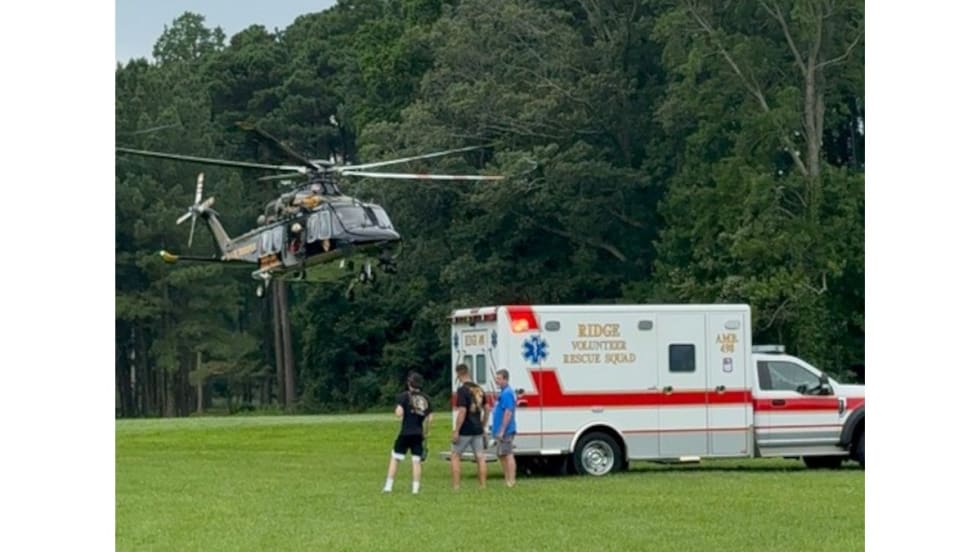
Maryland State Police Helicopter Rescues Victim from Overturned Boat in Chesapeake Bay
The Maryland State Police Aviation Command Trooper 7 crew, the MSP helicopter based in California, Maryland, were monitoring the county dispatch radio, overheard the dispatch, and self-launched.
Read More →
3 Los Angeles County Deputies Killed in Explosion Friday Morning
At press time the names of the deputies had not been released. Sheriff Robert Luna said one had served for 19 years, another for 22 years, and another for 33 years.
Read More →

